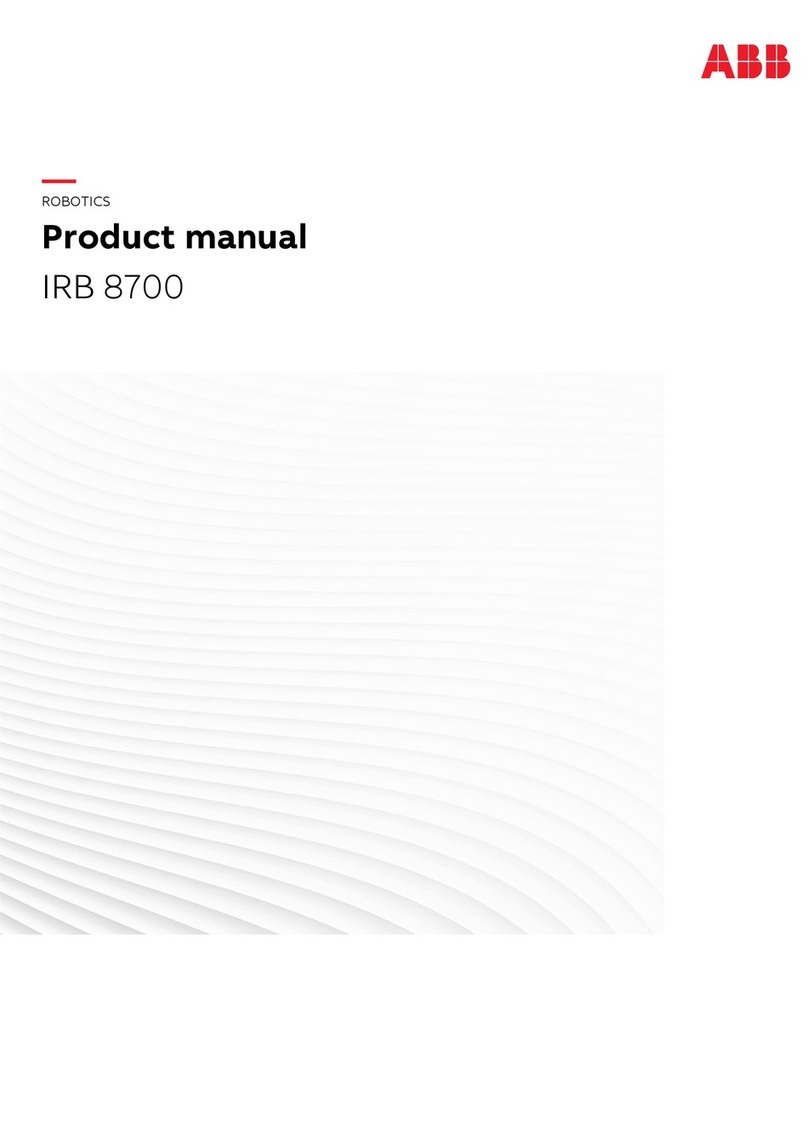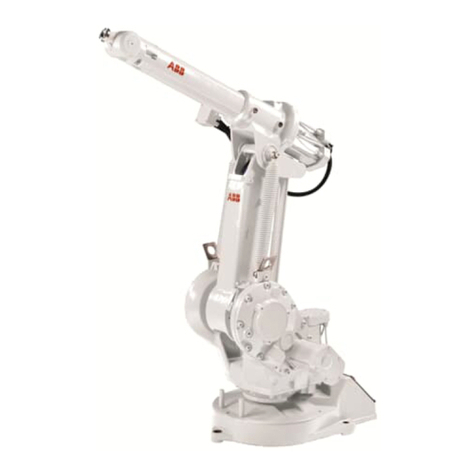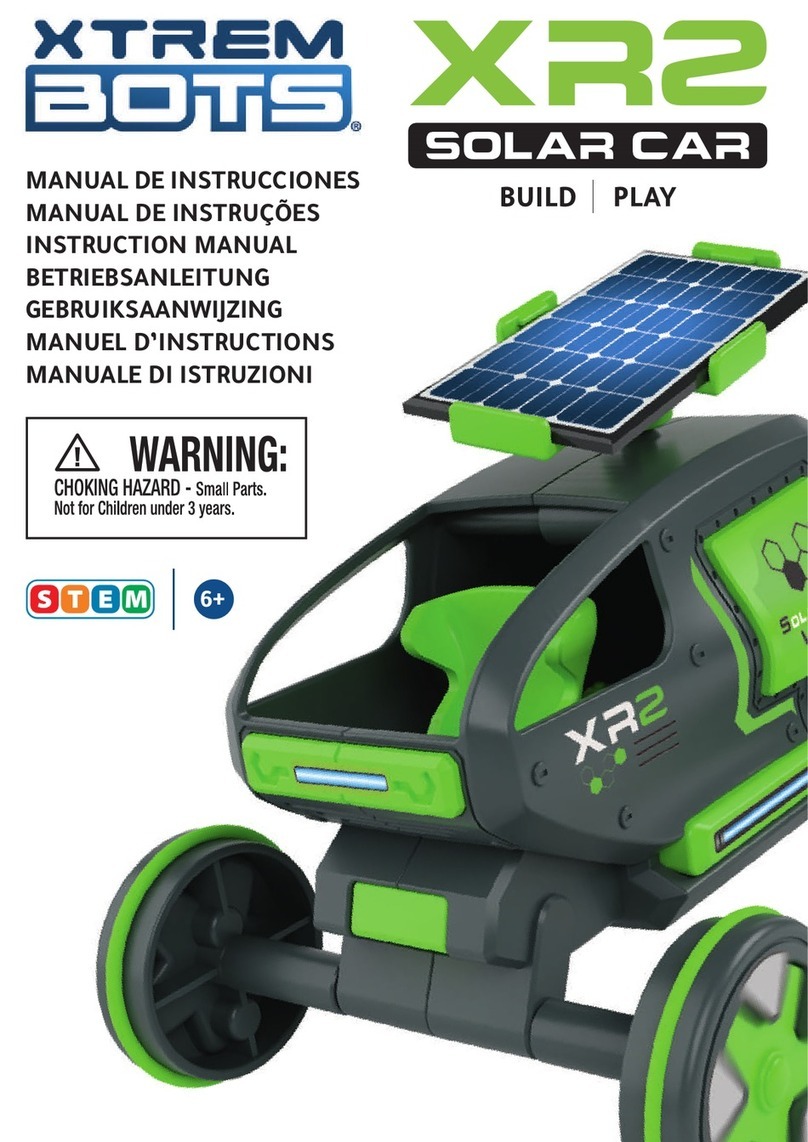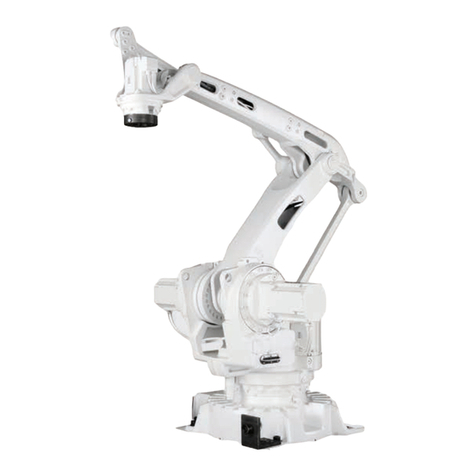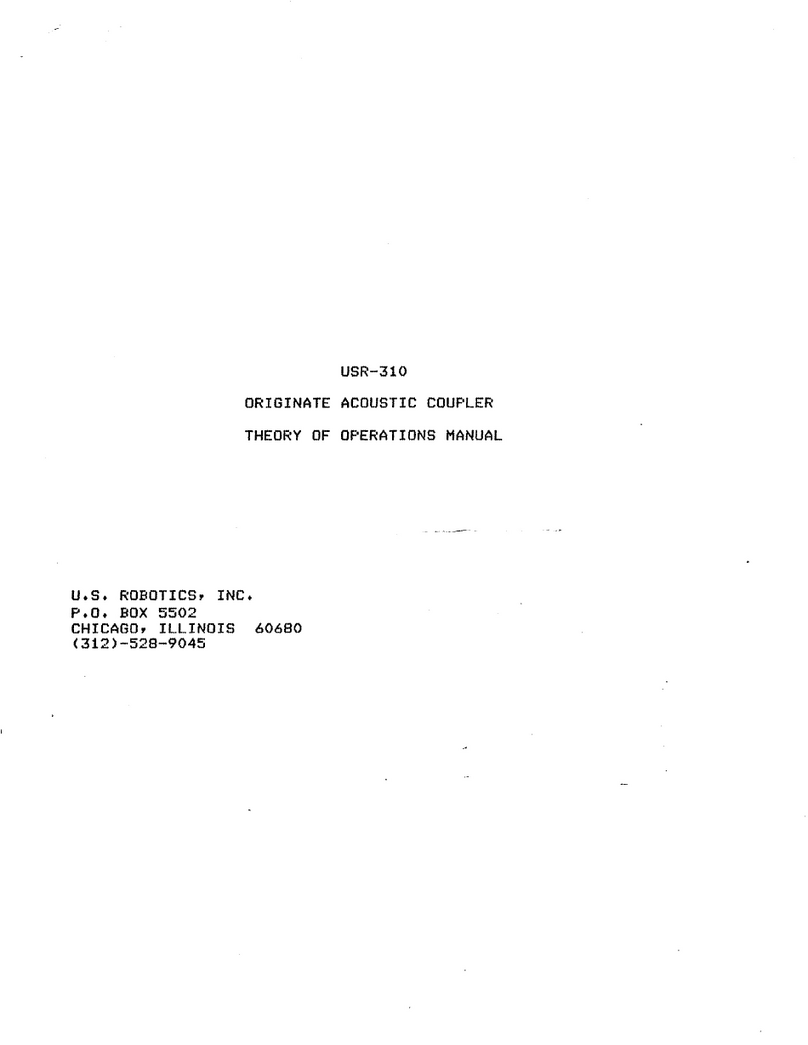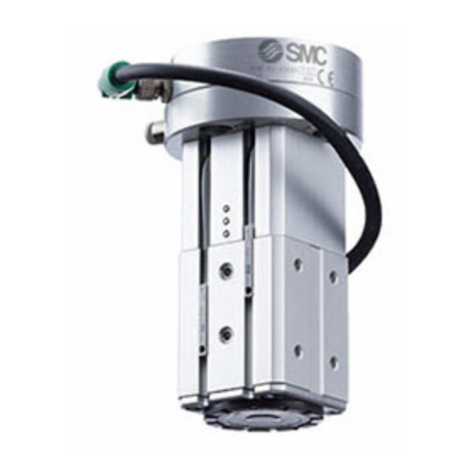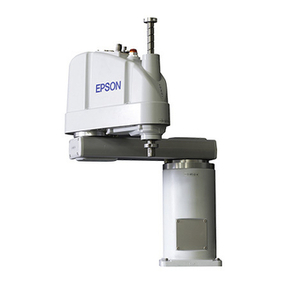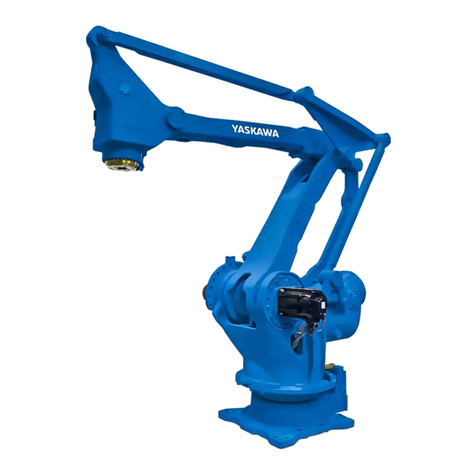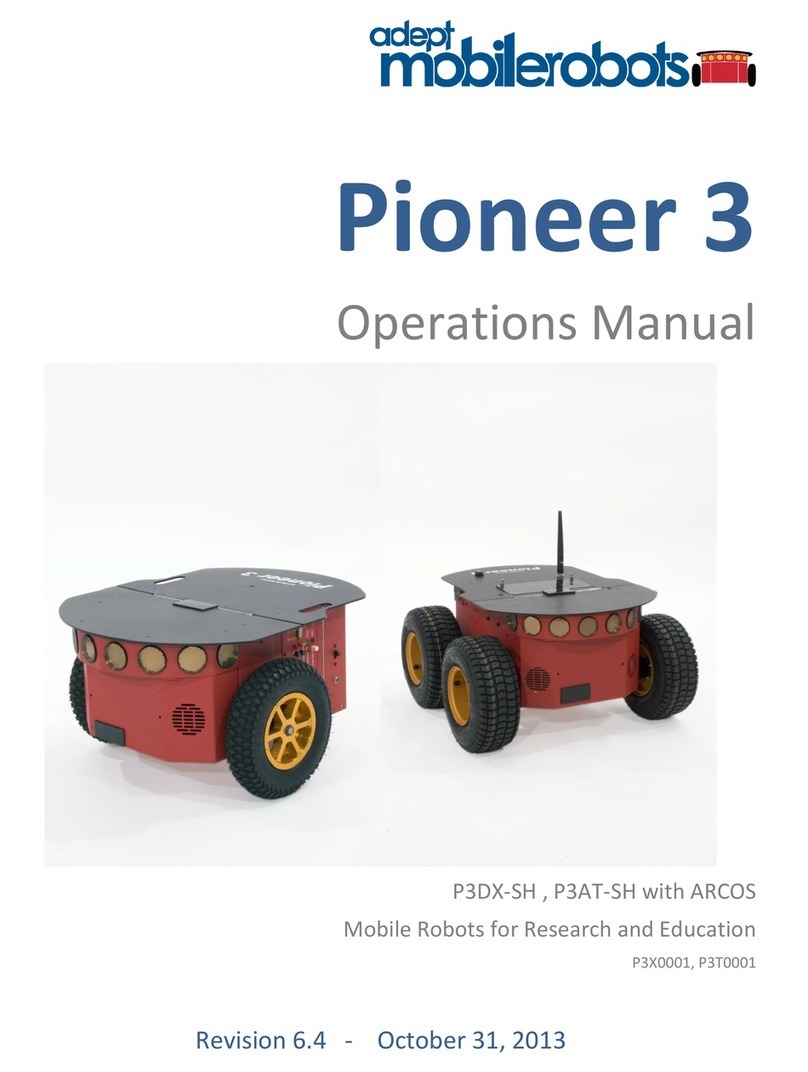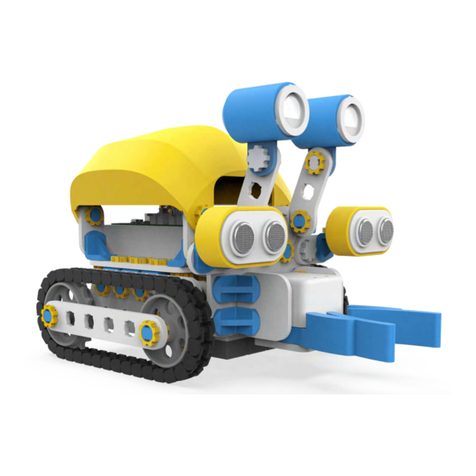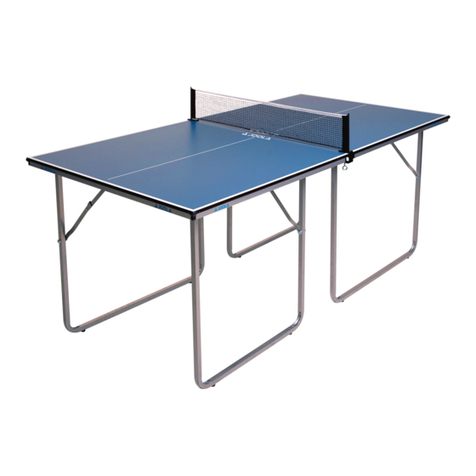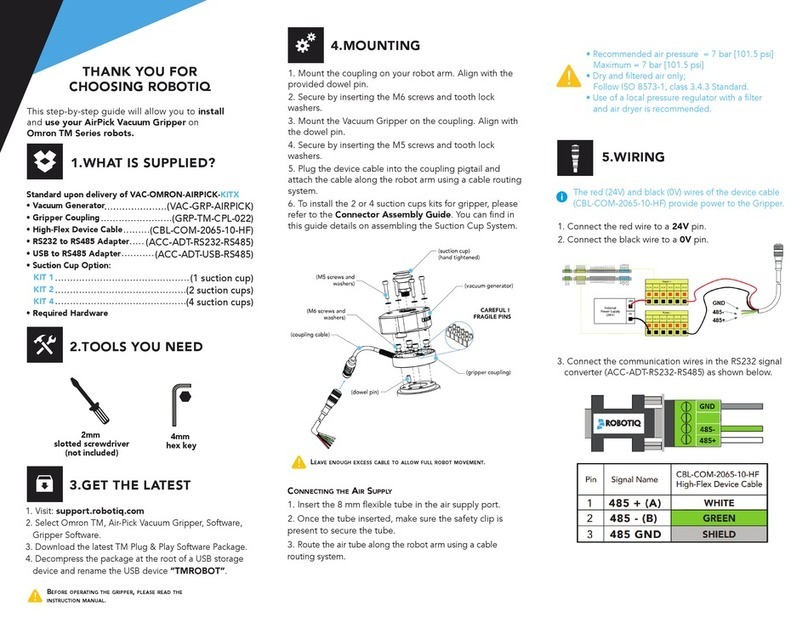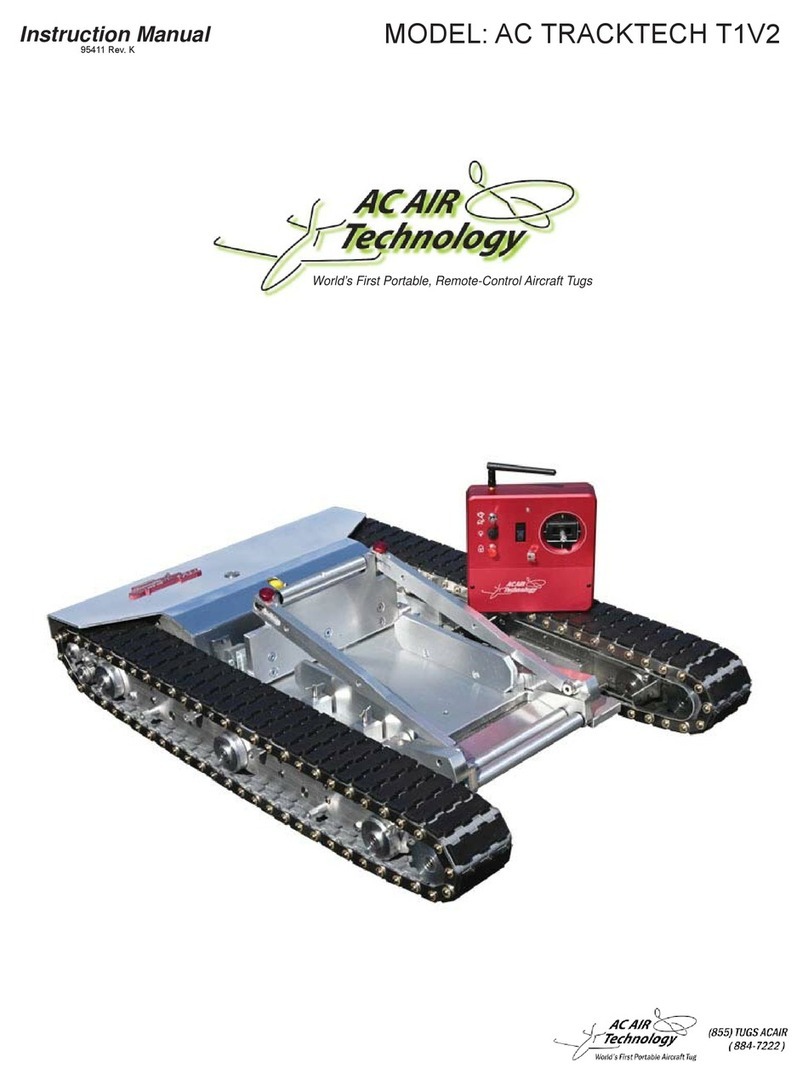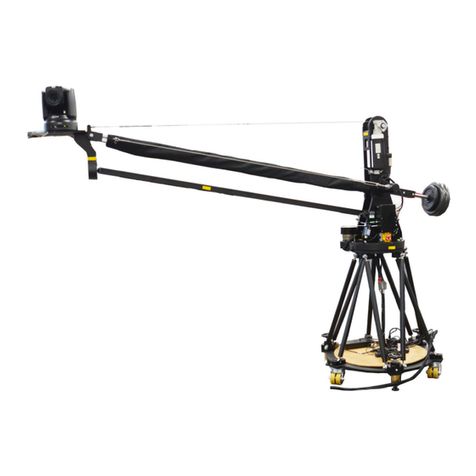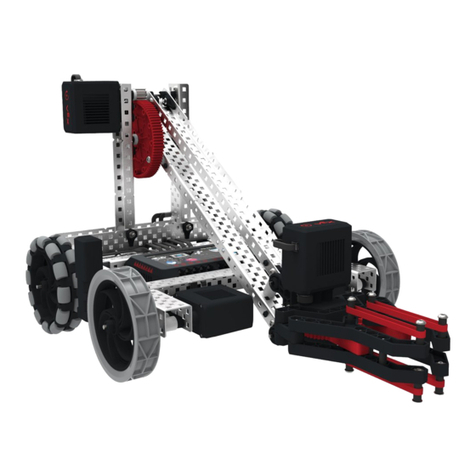Newgy Industries Robo-Pong 2040+ User manual

•Quick Set-Up, 545 ...........3
•Quick Set-Up, 1040+ ....... 4
•Quick Set-Up, 2040+ .......5
•Operation ....................... 7
•Robot Positions .............13
•Misc. Adjustments .........14
•Important Notices ..........16
•Take-Down, 2040+ ........17
•Maintenance ................19
•Accessories ................... 20
•Troubleshooting ............ 20
•Exploded Views ............23
•Parts List ....................... 25
•Training Log .................. 27
•Warranty & Repair
(Back Cover)
Important:
read operatIng
InstructIons
carefully
newgy table tennIs robot
OWNER'S MANUAL
For Models 2040+, 1040+ & 545
Manufactured under one or more of the following U.S. patents: 4,844,458;
4,854,588; 4,917,380; 5,009,421; 5,335,905; 5,383,658; 5,485,995; and
6,406,386. Also covered by multiple foreign patents/patents pending. Robo-Pong,
Pong-Master, Robo-Balls, and Newgy are trademarks of Newgy Industries, Inc.,
Tennessee, USA.
© January 2018
Newgy INdustrIes, INc.
teNNessee, usA
800-556-3949
615-452-6470
Newgy@Newgy.com
www.Newgy.com
14
4

2
© October 2018 by Newgy Industries, Inc.. This manual, including all photographs, illustrations and software, is protected by
International Copyright Law, with all rights reserved. The manual and any materials contained therein may not be copied
without the author's written permission.
DISCLAIMER
The manufacturer makes no warranties with respect to the contents of this manual, and expressly waives any implied warran-
ty for the particular purpose of sale or interest. The manufacturer reserves the right to make any amendments or changes to
the contents of this manual, and assumes no responsibility for notifying any individual of such amendments or changes. The
specifications and parameters provided in this manual are provided as is and subject to change without notice. The ultimate
power of interpretation belongs to Newgy Industries, Inc..

ADJUST HEAD ANGLE
Loosen the Brass
Knob on the right
side of the robot
(as you’re facing
it), and angle the head down as
far as possible and then re-tight-
en. Verify that the word “top-
spin” is at the top of the ball dis-
charge hole. (See Figures 4, 5, & 7
on pages 7 and 8 for more info.)
POSITION ROBOT ON TABLE
Position the robot in
the center of the
table close to the
endline as shown.
The robot’s head should be in line
with the centerline of the table
(Robot position 1, Figure 15, page 12).
NEWGY TABLE TENNIS ROBOT SYSTEM
QUICK SET-UP FOR ROBO-PONG 545
The Newgy Table Tennis Robot System includes Robo-
Pong models 545, 1040+, and 2040+. Upgrade kits are
incorporated into the system to enable a customer to retain
their investment in their robot and to add features and
capabilities as needed. These upgrades consist of the Robo-
Pong 545 Upgrade Kit to convert a 545 into a 1040+ and the
Recycling Net Upgrade Kit to transform a 1040+ into a
2040+.
Robo-Pong robots require no assembly or tools. They
are pre-assembled and factory tested before being packed
and shipped. They only require a brief set-up before
they’re ready for play! The following quick set-up steps
will assist you in properly setting up your robot.
If you purchased a 2040+, a video is included that also
explains set-up and operation. Additionally, the video
includes some simple table tennis techniques for returning
the different spins your robot can deliver (also see page 8).
Please view the video first if you have a video player.
For maximum enjoyment of and benefit from your
Robo-Pong, it's best to follow the simple set-up steps as
outlined below or as shown in the video. Later chapters of
this Owner'sManual will discuss in detail robot operation,
complete disassembly, maintenance, troubleshooting,
accessories, parts replacement, service, and warranty. In
general, instructions will apply to all models except when
clearly designated by a caption, heading, or the following
footnotes: 1Robo-Pong 1040+ only, 2Robo-Pong 2040+ only,
or 5Robo-Pong 545 only.
The rObO-POng Training Manual in your robot pack-
age (for 2040+ models sold from the U.S.) explains in detail
table tennis strokes, spins, serves, footwork, and other
techniques. It also tells how to use your robot for fitness
training and as fun entertainment for kids and adults. If
you purchased a 1040+ or 545 model, you can download
the Training Manual from our website, www.newgy.com.
In addition, there is a wealth of coaching articles and other
information on our website.
Your robot comes with a supply of Newgy 40mm
Robo-Balls (for robots sold from the U.S.). Robo-Balls are
specially selected for the best robot performance possible.
To order additional balls, Training Manual, video,
upgrade kits, or any other robot accessory or part, please
contact Newgy Customer Service or visit our website.
Contact info is given on the front cover of this manual.
GENERAL INSTRUCTIONS
3
VERIFY ALL PARTS
Unpack all the parts and check that all parts
are present. If unable to identify a part, look
for a small silver label with the name of the
part. If any part is missing, please contact
Newgy immediately. You may want to keep your box and
styrofoam pieces in case you ever need to ship your robot.
WASH BALLS, THEN PLACE IN BUCKET
Open the bag(s) of balls and wash them in
lukewarm, soapy water. Then rinse in clear
water and dry. Place the washed balls in the
Ball Bucket. Other new balls you use should
be washed and dried before placing them in the bucket.
You may also include used balls with worn surfaces. All
balls must be 40mm.
CONNECT CABLE TO ROBOT
Plug one end of the
Connector Cable into the
5-Pin Connector on the
back of the robot as
shown. (Also see Figure 17, page 13.)
1
2
3
4
5
➨
➨
Warranty &
Tell-A-Friend
Flyer
Quick Start
Guide
Pong Pal
(U.S. Only)

GET READY TO PLAY!
With your paddle in your playing hand, turn
the Ball Speed knob to 2–3 and the Ball
Frequency knob to 4–5. It takes about 30 sec-
onds for the balls to load up before the first
one is delivered. To become more familiar with the controls
and adjustments for your machine, read the OPeraTiOn sec-
tion of this manual starting on page 6.
FOLLOW STEPS 2–6 OF 545 SET-UP
Follow Steps 2–6 of the set-up instructions
for Robo-Pong 545 on the opposite page and
above.
SET CONTROL LEVERS TO 3 & 4
Verify that the
Oscillator
Control Levers
are in the 3 & 4
positions. If not, pick up
slightly on the lever and
swing it or the lever guard
into the correct position.
More info on oscillator
adjustment is on page 9.
CONNECT CABLES TO CONTROL BOX
Plug the Connector
Cable into the 5-pin
socket on the rear of
the Control Box. Then
insert the Trans-
former’s pin into the adjacent
Power Jack (see Figure 2B, page 6).
Position the Control Box at the corner of the table (See
Figure 15, page 12).
8
ATTACH CABLE CLIP TO TABLE
Bring the free end
of Connector Cable
to the player’s end
of the table.
Remove the protective backing
from the bottom of the Cable Clip.
Press it onto the side of the table
about 12 inches from the end in a
horizontal position. If you’re right-handed, place it on the
left side of the table. If you’re left-handed, place it on the
right side of the table. Open the clip and place the
Connector Cable and the Transformer’s cord inside the clip
so approximately 12 inches of cable are free. Close the clip.
Plug the Transformer into a suitable electric power source
as printed on top of the Transformer.
7
6
VERIFY ALL PARTS
Unpack all the parts and check that all are
present. If unable to identify a part, look for
a small silver label with the part name. If any
part is missing, please contact Newgy imme-
diately. You may want to keep your box and styrofoam
pieces in case you ever need to ship your robot.
ATTACH BUCKET EXTENDER
Slide the Bucket
Extender onto the
top of the bucket
so that the hooks
on the bottom of the Extender
capture the top lip of the Bucket.
Stop when the hook on the front
of the Extender grabs the front
lip of the Bucket. It may be nec-
essary to lift the rear of the
Extender over the Locating Tab protruding above the rear
lip of the Bucket. Reattach the Robot Body to the Bucket by
reversing step 2.
QUICK SET-UP FOR ROBO-PONG 1040+
4
Locating
Tab
1
3
4
5
DETACH ROBOT BODY
Loosen the two Wing
Nuts holding your
robot body onto the
Ball Bucket. Rotate
the black, rectangular Clip Washers
180˚. Pull the Robot Body off the
bucket.
2
➨
➨
Cable
Clip
Warranty &
Tell-A-Friend
Flyer
Quick Start
Guide
Pong Pal
(U.S. Only)

PULL DOWN SUPPORT LEGS
Place the robot on the
table with the open
front side facing you.
Pull the curved black
metal support legs
toward you.
5
CONNECT CABLES TO CONTROL BOX
Bring the free end
of Connector
Cable to the play-
er’s end of the
table. Plug the Connector Cable
into the 5-pin socket on the bot-
tom of the Control Box. Then insert the Transformer’s pin
into the Power Jack of the Control Box (see Figure 1B, page 6).
ATTACH CONTROL BOX TO TABLE
Place the Control Box
on the side of the table
about one foot from
the end. If you're
right-handed, place it on the left side
of the table. If you're left-handed,
place it on the right side. (See Figure
15, page 12 for more detail.) Plug the Transformer into any
suitable electric power source. Transformer specifications
are printed on top of the Transformer.
7
6GET READY TO PLAY!
Turn Oscillator Speed on and when the head
aligns with the centerline of the table, turn
Oscillator Speed off. Pick up your paddle,
turn the Ball Speed knob to 2–3 and the Ball
Frequency knob to 4–5. Turn the Power
switch to “on” and get ready to return the ball. It takes
about 30 seconds for the balls to load up before the first
one is delivered. When you’re ready for random delivery,
turn the Oscillator Speed on and the balls will be randomly
delivered across the entire table. To become more familiar
with the controls and adjustments for your machine, read
the OPeraTiOn section of this manual starting on page 6.
8
QUICK SET-UP FOR ROBO-PONG 2040+
VERIFY ALL PARTS
Unpack all the parts and check that all are
present. If unable to identify a part, look for
a small silver label with the part name. If a
part is missing, please contact Newgy. You
may want to keep your box and styrofoam pieces in case
you need to ship your robot. If you purchased Pong-Master,
check the photo below to verify all of its parts. In your
Owner’s Packet is a separate
Ow n e r ’sM a n u a l for Pong-
Master. That manual will tell you
how to set up and operate Pong-
Master. To help you separate
robot parts from Pong-Master
parts, the silver labels have “RP”
before the part names for the
robot and a “PM” before the part
names for Pong-Master.
1
SPREAD SUPPORT LEGS APART
Spread out the sup-
port legs to their
fully open position.
JOIN NET SUPPORT TUBES
Turn the robot around
180° so the Net
Support Tubes are now
facing you. Grasp the
second tube from the right and pull
up, removing it from its storage hole.
Place the bottom of this tube into the
top of the first tube on the right as
shown. Repeat on the left side.
2
3
4
Support Legs
Joining Net Support Tubes
➨
➨
➨
Pong Pal
(U.S. Only)

SET CONTROL LEVERS TO 3 & 4
Walk around
to the rear of
the robot, open
the slot in the
back of the net by pulling the
velcro apart and verify that
the Oscillator Control Levers
are in the 3 & 4 positions. If
not, pick up slightly on a
lever and swing the lever or
lever guard into the correct
position. (See page 9 for more details.)
6
LOWER BALL TRAYS
Grasp one of the Ball Return Trays, lift
straight up to unlock it, grasp the adjacent
Net Support Tube, and slowly lower them
into position. Be careful not to let the tray or
support tube slam down. Repeat on the other side.
58
ATTACH ROBOT TO TABLE
Pick up the robot by the bottom of the
Center Trough and secure it to the table by
angling it downward and pushing it onto
the end of the table. The Support Legs go
underneath the table and the Front Support Plate sits on
top of the table. The center of the Front Support Plate
aligns with the centerline of the table. The robot will be
held by its own weight. (See Figure 10, page 9 for more detail.)
FOLLOW STEPS 2–5 OF 545 SET-UP
Follow steps 2–5 of the set-up instructions
for Robo-Pong 545 on, except after washing
the balls, place them in the robot’s Ball
Return Trays instead of the Ball Bucket.
7
FOLLOW STEPS 6–8 OF 1040+ SET-UP
Follow Steps 6 to 7 of the set-up instructions
for Robo-Pong 1040+ on the opposite page.
69
➨
➨
➨
ATTACH SIDE NETS
Attach a Side Net to
your table tennis net
by slipping the red
flexible band over
your table net's support base and
wrapping it around the table net's
clamp screw. (If your table net
doesn't have these parts, see Figure
18 on page 20 for alternative Side Net attachment). Be sure
Side Net follows and is directly above the sideline of the
table. Repeat on the other side (see page 20 for more details).
10

Linking Cable from Pong-Master
Scoreboard (optional) plugs in here
CONTROL BOX FOR 1040+/2040+
TOP VIEW
FIGURE 1A
1 3 42
If you open Control Box, remove ONLY these 4 screws
Connector Cable from
robot plugs in here
Pin of Transformer
plugs in here
CONTROL BOX FOR 545
TOP VIEW
FIGURE 2A CONTROL BOX FOR 545
REAR VIEW
13
2
Connector Cable from
robot plugs in here
Pin of Transformer
plugs in here
7
OPERATION OF YOUR ROBOT
Your robot is extremely versatile and fully adjustable to
suit a wide variety of playing abilities and styles. Ball
speed, frequency, spin, trajectory, and placement can all be
adjusted, as well as oscillator speed and range. The follow-
ing section will explain the various controls and adjust-
ments of your robot.
CONTROL BOX (ALL MODELS)
The robot’s motors are controlled electronically by the
Control Box. Figures 1A and 1B illustrate the functions and
controls for the 1040+ & 2040+ models. Figures 2A and 2B
illustrate the functions and controls for the 545.
1. POWER—Used to turn the robot “ON” or “OFF”.
2. BALL SPEED—Regulates the ball speed and spin.
Higher settings increase the amount of spin and forward
speed on the ball. On the 545, this control also functions as
the on/off switch. See also Ball Trajectory on page 7.
3. BALL FREQUENCY—Regulates the time between
shots. Lower settings increase the time between shots.
Higher settings decrease time between shots. Lowest set-
ting at which balls will come out is approximately 2 (13 to
26 balls per minute). At a setting of 10, the robot delivers
approximately 90 balls per minute for the 1040+ & 2040+
models and 60 balls per minute for the 545.
4. OSCILLATOR SPEED—Regulates the speed at
which the robot head sweeps side to side. Higher settings
make the head sweep faster. This control is also used to
position the head in the desired direction when you want
balls to be delivered to one spot. First set the control levers
on the rear of the robot to positions 3 & 4 (see page 9). Turn
Oscillator Speed on, and when the head reaches the desired
position, turn it off. See also Figures 3A & 3B below.
WARNING: Use the Oscillator Speed control to make the
robot head move sideways. DO NOT attempt to move the robot
head sideways by hand. Doing so will likely result in broken
parts and may void your warranty.
FIGURE 2B
CONTROL BOX FOR 1040+/2040+
BOTTOM VIEW
FIGURE 1B
FIGURE 3A FIGURE 3B
Because oscillator speed has not
been set correctly, the second ball is
placed too closely to the first ball.
This results in not having to move the
feet very much.
Oscillator speed has been adjusted
so the second ball lands well away
from the first ball. This makes the
player move the feet a greater
distance, resulting in better footwork
and more exercise.
1
21
2
INCORRECT OSCILLATOR SPEED
(1040+/2040+ ONLY)
CORRECT OSCILLATOR SPEED
(1040+/2040+ ONLY)

8
BALL TRAJECTORY (ALL MODELS)
The trajectory of a ball is regulated by adjusting the angle
of the robot head. The angle can be changed from low to
high. At its lowest setting, the ball will be delivered so it
first strikes the robot's side of the table, bounces over the
net, and lands on the player's side of the table (just like a
serve). At its highest setting, the ball will be delivered in a
high arc over the net (like a lob return).
The trajectory is adjusted by loosening the Brass Knob
on the right side of the robot head, tilting the head to the
desired angle and then re-tightening the Brass Knob (see
Figure 4). For reference, there are head angle indicators
next to the Brass Knob (see Figure 5).
WARNING: DO NOT adjust the head angle when the
head is moving side to side. Failure to follow these instructions
will likely result in broken parts and may void your warranty.
The ball trajectory setting is directly related to the Ball
Speed setting. When the head is set so the ball first strikes
the robot's side of the table (robot “serving”—see Figures
6C & 6D), maximum Ball Speed is 3–5. As the Ball Speed is
turned up, the head must be angled up to deliver the ball
so it first strikes the player's side of the table (robot
“returning”—see Figures 6A & 6B). As the Ball Speed is
turned up even more, adjust the head angle down to pre-
vent the ball from being thrown off the end of the table.
INCORRECT ROBOT HEAD ANGLE,
ROBOT “RETURNING”
FIGURE 6A
ADJUSTING HEAD ANGLE
FIGURE 4 HEAD ANGLE INDICATORS
FIGURE 5
CORRECT ROBOT HEAD ANGLE,
ROBOT “RETURNING”
FIGURE 6B
INCORRECT ROBOT HEAD ANGLE,
ROBOT SERVING
FIGURE 6C
CORRECT ROBOT HEAD ANGLE,
ROBOT SERVING
FIGURE 6D
Robot head is tilted too high, resulting
in ball being thrown off the end of the
table.
Same ball speed as Figure 6A, but
now robot head is tilted down so the
ball lands on the table.
When robot is set to serve onto its
side of table first, and the head angle
is too severe, the ball will rebound
abnormally high.
Same ball speed as Figure 6C, but
head angle has been raised slightly
so ball stays low to the net. With
robot serving, maximum ball speed is
limited to 3–5 before ball is thrown off
the end of table.
Robot Head
67
Brass Knob
71
Angle Pointer
Head Angle
Indicators
Robot Head
Robot Head
Robot Head
Loosen Brass Knob
(66) To Adjust Angle
Of Head Up Or
Down.
DO NOT FORCE!

BALL SPIN (ALL MODELS)
Robo-Pong robots are capable of putting any type of spin
on the ball. Topspin, backspin, sidespin, and even combina-
tion spins can easily be selected. To change the spin, simply
rotate the head of the robot until the desired spin is at the
top of the Ball Discharge Hole (see Figure 7).
For combination spins, move the head until one of the
rotational arrows is at the top of the Ball Discharge Hole.
For instance, if the arrow between Topspin and Sidespin is
selected, the robot will deliver a ball containing both top-
spin and sidespin. Likewise, if the arrow between Backspin
and Sidespin is selected, the robot will deliver a combina-
tion backspin/sidespin ball.
Before discussing how to return spins, it's important to
know that your robot simulates the play of a modern table
tennis professional using inverted sponge rubber. With
Robo-Pong robots, there is always some kind of spin on the
ball. To learn how to produce your own spin and return an
opponent’s (or the robot’s) spin, it is important to use the
correct equipment—a quality inverted or pips out sponge
rubber racket. Using old-style paddles such as hard rubber
or sandpaper will make it more difficult to control spin.
Each spin has a different effect on the ball and how the
ball reacts when you strike it with your paddle. Following
are some brief pointers to help you return the different
spins. More detail is available in Chapter 7 of the Training
Manual which is included with your Robo-Pong 2040+ if
bought in the U.S., or available separately.
The secret to returning spin is to angle your paddle
correctly when contacting the ball. Any spin can easily be
returned if you angle your paddle properly. Set your pad-
dle angle at the beginning of your stroke and maintain the
same angle until your stroke ends. Avoid changing your
paddle angle during your stroke. (See Figure 8.)
9
Rotate Head So
Desired Spin Is
Listed In Upright
Position
CAUTION:
Do Not Twist Power
Cord Around Head.
Rotate No More
Than 180° In Either
Direction From
Position Shown
SPIN SELECTION
FIGURE 7
TOPSPIN
SIDE VIEW
BACKSPIN
SIDE VIEW
PADDLE
PADDLE
LEFT SIDESPIN
TOP VIEW
RIGHT SIDESPIN
TOP VIEW
RETURN SHOT
RETURN SHOT
RETURN SHOT
PADDLE
PADDLE
RETURN SHOT
PADDLE ANGLE ADJUSTMENTS
FOR VARIOUS SPINS
FIGURE 8
Topspin causes the ball to dip downward as it travels
through the air. When you strike the ball with your paddle,
it has a tendency to pop up high in the air. To compensate
for topspin, angle your paddle face down as you stroke
through the ball in a forward and upward direction.
Contact the top surface of the ball. (See Figure 8A.)
Backspin causes the ball to rise upward and float as it
travels through the air. When you strike the ball with your
paddle, it has a tendency to go straight down into the table.
To compensate for backspin, angle your paddle face
upward as you push your paddle straight forward. Contact
the bottom surface of the ball. (See Figure 8B.)
Sidespin makes the ball curve sideways through the
air. Left sidespin makes the ball rebound off your paddle to
your right; right sidespin to the left. To compensate for left
sidespin, angle the paddle face to the left and contact the
right side of the ball. To compensate for right sidespin,
angle your paddle face to the right and contact the left sur-
face of the ball. (See Figures 8C &8D.)
Combination spins take on the characteristics of both
spins, although to a lesser degree than the pure spins. To
compensate for topspin/right sidespin, you must angle
your paddle face down and to the right and contact the top
left surface of the ball. Likewise, a backspin/left sidespin
ball is best returned by angling your paddle face up and to
the left and contacting the ball on its bottom right surface.
Spins are increased by turning up the Ball Speed knob
on the Control Box. You increase both the speed and spin
on the ball every time you turn up the Ball Speed knob. It is
not possible to adjust Robo-Pong robots to deliver a slow
ball with lots of spin, for instance. It is also impossible for
Robo-Pong robots to deliver a no-spin ball. Additionally,
since backspin causes the ball to rise, the maximum setting
for Ball Speed when the robot is set on Backspin is approxi-
mately 4–5.
AB
CD

10
OSCILLATION RANGE (1040+/2040+ ONLY)
Oscillation is the sweeping motion of the robot’s head,
enabling the robot to deliver consecutive balls to different
spots on the table. Since Robo-Pong 545 has no oscillation
controls, the information on this page does not apply to the
545. Furthermore, the oscillator ranges given on this page
will apply to the 1040+ and 2040+ only when these models
are positioned so the robot head is aligned with the center-
line of the table (Position 1 or 5, Figure 15, page 12).
Models 1040+ and 2040+ have 8 selectable ranges (or
zones) in which the robot head will sweep, delivering balls
randomly within that zone. These zones are regulated by
the Control Levers at the back of the robot (see Figure 9).
Ranges are identified on a label at the top of the robot (see
Figure 10). Figure 10A further clarifies these ranges.
Zones are selected by moving a Control Lever into the
desired position as indicated by the number that appears
through the hole in the Control Lever (see Figure 9). The
Right Control Lever is restricted to positions 1, 2, & 3; the
left to positions 4, 5, & 6. (Left and right designations for
the robot are given as if you are facing the robot.)
To move a lever, lift it up with your finger, move it to
the desired position, and then release it. If the lever will
not move easily, pick up the lever and move the Control
Lever Adapter instead. To access the Control Levers on the
2040+, open the slot in the back of the net by pulling the
velcro apart and reach with your fingers through the slot to
touch the Control Levers.
WARNING: DO NOT adjust the Control Levers while the
head is moving. Also do not move both levers at the same time.
Move one, then the other. Failure to follow these instructions will
likely result in broken parts and may void your warranty.
Following is an explanation of each zone that can be
selected as shown in Figures 10 and 10A:
3,4—Robot delivers balls across the entire table, from
corner to corner (whole table).
3,5—Robot delivers balls from player’s left corner to
middle of right court (3
/4table).
2,4—Robot delivers balls from player’s right corner to
middle of left court (3
/4table).
1,4—Robot delivers balls from player’s right corner to
centerline (1
/2table).
3,6—Robot delivers balls from player’s left corner to
centerline (1
/2table).
2,5—Robot delivers balls from middle of player’s right
court to middle of left court (1
/2table).
1,5—Robot delivers balls from middle of player’s right
court to centerline (1
/4table).
2,6—Robot delivers balls from middle of player’s left
court to centerline (1
/4table).
1,6—No oscillation. Place Control Levers in these posi-
tions whenever you transport or ship your robot, to pre-
vent damage to the oscillator mechanism.
If you want stationary delivery, adjust the Control
Levers to 3,4 and turn oscillator speed on. When the robot
head points to the desired landing spot on the table, turn
Oscillator Speed off. Failure to set the levers to 3,4 may
result in “head drift”, which causes the landing spot to
change even though the oscillator is turned off.
SWEEP CONTROL ADJUSTMENT
2-4
3-4
1-4 3-6
2-5
1-5 2-6
3-5
OSCILLATOR RANGES
OF ROBOT WITH
CONTROL LEVERS IN
VARIOUS POSITIONS
AND ROBOT ALIGNED
WITH CENTERLINE OF
TABLE
(1040+/2040+ ONLY)
FIGURE 10A
SWEEP ADJUSTMENT LABEL
(1040+/2040+ ONLY)
FIGURE 10
OSCILLATOR CONTROL LEVERS
TOP VIEW (1040+/2040+ ONLY)
FIGURE 9
CAUTION:
Do Not Move Robot
Head By Hand; Use
Oscillator Speed Knob
On Control Box
Numbered Oscillator
Positions
81
Control Lever, L
80
Control Lever
Adapter
82
Control
Lever, R
SWEEP CONTROL ADJUSTMENT
2-4
3-4
1-4 3-6
2-5
1-5 2-6
3-5

FINAL PROCEDURES
Place balls of the other size in the Ball Bucket or
Ball Trays. (Be sure to wash and dry new balls
before using them for the first time.) Reconnect
the Connector Cable (see Figure 17, page 13). Turn
power back on and you’re ready to play.
REATTACH ROBOT BODY
Reattach the Clear Front
Cover (reverse of Step 6).
Reattach the robot body, mak-
ing sure that it fits fully down
on the locating tab of the Center Trough
or Ball Bucket. (See Figure 17, page 13.)
Finally, re-tighten the Wing Nuts
(reverse of Step 4).
➦
REMOVE BALLS FROM INSIDE ROBOT
Remove all balls
from inside the
robot and place
in the box with
the other balls of the
same size. Also gather up
any balls that are on the
floor or lying around
loose in the playing area and place them inside the box too.
REMOVE CLEAR FRONT COVER
Place the robot body
on your table. Pull
the Clear Front
Cover off by squeez-
ing on the circular fingerholds
on the sides of the cover with
your thumb and forefinger,
and then pulling up while squeezing. Pull the cover loose
first at the top and then at the bottom.
➥
REMOVE BALLS FROM TRAY OR BUCKET
First, remove all balls
from the Bucket (545
or 1040+) or Trays
(2040+) and place
them in a box where they will
not get mixed in with balls of
the other size. Then disconnect
the Connector Cable from the
back of the robot.
LOOSEN WING NUTS
Loosen the two Wing
Nuts that hold your
robot body onto the
Ball Bucket or Center
Trough. Rotate the
black, rectangular Clip Washers
180˚.
REMOVE ROBOT BODY
Pull straight up on the
robot body to remove it
from the Ball Bucket or
Center Trough.
3
1
2
➥
7
5
6
4
REMOVING ALL BALLS FROM THE SYSTEM
➥
➨
➦
11
Clip Washer

BALL DAMS (2040+ ONLY)
Robo-Pong 2040+ comes with a pair of Ball Dams. They
serve three functions: (1) they keep balls inside the Center
Trough when the robot is folded up, (2) they keep balls
from entering the Center Trough when you want to remove
the robot body, and (3) they serve as a ball gauge for deter-
mining if a ball is the proper size and whether it should be
used in the robot.
The Ball Dams, when used for functions 1 or 2, fit into
two retaining slots at the top of the Center Trough. When
not in use, the Ball Dams fit into their storage slots on the
side of the Center Trough (see Figure 11).
To use the Ball Dams when preparing the robot for
storage or transport, remove the Ball Dams from their stor-
age slots by pulling slightly up on the trays to reveal the
storage slots (see Figure 13). Then push all the balls into the
Center Trough and insert the Ball Dams into their retaining
slots (see Figure 12). To use the Ball Dams for function #2,
push the balls up into one of the Ball Return Trays and
quickly insert the Ball Dam into its retaining slot before the
balls can roll down into the Center Trough. The balls will
be out of the way and you can easily loosen the two wing
nuts and two clip washers, then pull up on the robot body
to remove it (see Steps 4 & 5, opposite page).
The hole in a Ball Dam serve as a handy ball checking
feature. The hole is 40mm in diameter. This hole is used to
test the roundness and size of balls you use in the robot. If
you suspect a ball is out of round or too large, as indicated
by balls jamming within the robot, insert the suspected ball
into the ball checker hole. With your fingers, rotate it
around inside the hole to check all possible diameters of
the ball. The ball should have equal clearance through the
hole on all diameters. The ball should barely fit through the
hole without binding. It is also possible that a ball is too
small. In this case, you will notice a considerable gap
between the ball and the edge of the hole.
Ball Dam
Retainer Slot
Ball Dam
Storage Slot
Ball
Checker
Hole
15
Ball Dam
1
Center
Trough
BALL DAM & CENTER TROUGH
(2040+ ONLY)
FIGURE 11
INSERTING BALL DAM
(2040+ ONLY)
FIGURE 12
REMOVING BALL DAM
(2040+ ONLY)
FIGURE 13
CHECKING BALL WITH BALL DAM
(2040+ ONLY)
FIGURE 14
12
➥
➨
➨
Rotate Ball Inside
Hole To Check All
Diameters Of The
Ball. Ball Should
Pass Easily Through
Hole On All
Diameters.

POSITIONING YOUR ROBOT AND CONTROLS (ALL MODELS)
13
Robo-Pong robots are versatile in how they are positioned
in relation to the table. The 545 and 1040+ normally sit on
top of the table as shown in robot positions 1–4 in Figure
15. They can also be mounted in the optional Robo-Caddy
and placed behind the table like positions 5 & 6. The 2040+
is typically mounted to the end of the table at position 5,
but can alternatively be mounted in the Robo-Caddy just
like the 545 and 1040+.
Some positions offer certain advantages while other
positions compromise some of the robot’s functions. By
placing the robot in various positions you can achieve a
variety of angles and trajectories to simulate almost any
type of shot you would encounter in a regular game. The
following paragraphs explain this further.
Position 1—Robot positioned square to the table where
the centerline and endline of the table meet. This is the only
“on the table” position in which the 1040+’s oscillator rang-
es will be accurate (see OscillatiOn Range, page 9). Also this
is the desired starting position when first setting up either
the 545 or the 1040+. In this position, the 545 will shoot
straight down the centerline of the table.
Position 2—Robot positioned at the far left corner and
angled cross-court. This position will skew the 1040+’s
oscillator range toward the player’s right side of the table.
The 545 in this position would deliver the ball towards the
player’s right corner. This position would be the preferred
direction when simulating typical right-handers’ forehand
to forehand rallies.
Position 3—Robot positioned at the far right corner
and angled cross-court. Setting the robot in this position
will skew the 1040+’s oscillator range toward the player’s
left side of the table. A 545 placed in this position would
direct its shots to the player’s left corner. Typical backhand
to backhand play for right-handers would be ideally simu-
lated with the robot in this position.
Position 4—A robot placed in this position has the
advantage of offering slower and faster ball speeds because
it is closer to the landing spot of the ball. At a Ball Speed
setting of 0, the ball is very slow and with light spin, but is
delivered deep on the player’s end. At a Ball Speed setting
of 10, the ball speed is very fast and simulates the angle
from which a typical kill shot would be hit. However, the
1040+’s oscillator ranges are narrower than if the robot had
been positioned at the endline like Positions 1–3.
Position 5—This is the normal position of the 2040+
when it is attached to the end of the table, and its net sys-
tem would function normally. The 1040+ and 545 would
have to be mounted in the Robo-Caddy to be in this posi-
tion. Positioned here, the 2040+’s and 1040+’s oscillator
ranges would be accurate.
Position 6—Mounted in a Robo-Caddy, all three mod-
els can be freely moved around in back of the table. The
Robo-Caddy also permits lowering or raising the height of
the robot. This is great for simulating deep shots such as
chops, lobs and loops. However, the oscillator ranges for
the 1040+ and 2040+ are not accurate and the 2040+’s net
system is usually not effective at capturing balls when in
this position. Additionally, you need to purchase a
Connector Extension Cable (part# 2000-221) to extend the
Robot
Pos. 1
Robot
Pos. 2
Robot
Pos. 3
Robot
Pos. 4
Robot
Pos. 5
Robot
Pos. 6
Right Hand
Player Left Hand
Player
545 Control Box
1040+/2040+ Control Box
A
ABB
length of the Connector Cable from 10 to 20 feet. This per-
mits the Control Box to stay within reach of the player.
These positions are only a few of the ones possible, but
they will give you a good idea of the pluses and minuses of
placing the robot in a particular position.
IMPORTANT NOTE: Even though the oscillator ranges
may not be accurate as described on page 9 when the robot is in
certain positions, you should be able, with experimentation, to
find the correct settings for the Control Levers to permit ball
delivery over any particular part of the table.
Figure 15 also illustrates the ideal positions for the
Control Box. If you’re right-handed, Position A is the pre-
ferred location for the controls. If you’re left-handed,
Position B is preferred. Locating the controls in these sug-
gested positions permits the controls to stay within easy
reach of the player’s free hand.
Since a player has a longer reach on the forehand side,
it is suggested that you position your body as shown. The
overwhelming majority of tournament level players use
their backhand to cover about one-third of the table and
their forehand to cover the other two-thirds of the table.
ROBOT AND CONTROL BOX
POSITIONS
FIGURE 15

14
LEVELING ADJUSTMENT (2040+ ONLY)
Robo-Pong 2040+ is designed to sit level when attached to
the table. In proper position (Figure 16), the CT Support
Legs fit underneath the table and the CT Front Support
Plate sits on top of the table. If the robot does not sit level,
balls will not feed properly. If this condition occurs, it is
necessary to make some leveling adjustments. The first
adjustment is to level the table top by placing shims under
the table legs until the table top is level.
If this does not cause the robot to sit level, then it will
be necessary to make adjustments to the robot itself. The
Support Legs come with 3 sizes of Rubber Tips and 4 rub-
ber spacer-washers to accommodate different table top
thicknesses, and cause the Center Trough to sit level. The
Rubber Tips are marked on their top with the table thick-
ness they are used with. The longest is used for 1
/2″tops.
The mid-size one is used on 3
/4″tops and comes pre-
installed. The shortest tip is used for 1″tops.
In addition to these different sized tips, there are 4 rub-
ber spacer-washers which are used with the Rubber Tips
for finer adjustments. Either one or two of these spacer-
washers (depending on how much adjustment you need)
are placed inside the Rubber Tips before the tips are placed
on the end of the Support Legs.
Another reason why your robot may not sit level is that
it is not properly seated on the locating tab. When seated
correctly, the Support Flange of the Back Panel sits flush on
the Locating Tab that protrudes from the top of the Center
Trough (see Figure 17). Your robot serial number is located
on top of this Support Flange.
Tip: If it is possible to adjust the level of the robot’s half
of the table independently from the player’s half, you may
choose to purposely give a slight slope to the robot’s half so
balls that end up on the table roll into the robot’s trays. If
you make the table unlevel, make sure the robot sits level
by adjusting the Rubber Tips as described above. In this
case, it may be necessary to use the Rubber Tip one size
larger than normal to level the robot.
ADJUSTING NET TENSION (2040+ ONLY)
The Ball Return Trays should sit level with or just below the level of
your table top. If the tension of the Main Net is too tight, the trays
will be pulled up into a slight “V” shape with the top edge of the
trays above the level of the table top. To correct this situation, you
can loosen the adjustment straps shown in Figure 18 until the trays
sit level. If this adjustment is insufficient, stretch the net by grab-
bing it with two hands and pulling gently apart.
The Trap Net (the black net with large holes) slows down your
returns so more of them are captured. The size of the holes is slight-
ly smaller than the diameter of a ball. Hard hit shots force the ball
through the net and the ball becomes trapped between the Trap Net
and the Main Net. When slowly hit balls contact the Trap Net, they
do not have enough force to go through the net, so they immediate-
ly drop down into the trays.
The Trap Net is normally hung loosely so as to increase its
energy-absorbing capability. If you are practicing hard hit shots like
smashes or fast loops, you may find that a tighter Trap Net cap-
tures more of your shots. The tension of the Trap Net is adjusted by
tightening or loosening the velcro straps at the sides of the Trap Net
(see Figure 19).
MISCELLANEOUS ADJUSTMENTS (2040+ ONLY)
CENTER TROUGH ATTACHMENT
(2040+ ONLY)
FIGURE 16
ADJUSTING MAIN NET TENSION
(2040+ ONLY)
FIGURE 18
ADJUSTING TRAP NET TENSION
(2040+ ONLY)
FIGURE 19
Table Tennis
Table
Back Of Robot
To Control
Box
Velcro
Straps
Robot
8,9
CT Support
Legs
95
Connector
Cable
Serial #
Located
Here
10,11,12
CT Support
Leg Rubber
Tip—Come
In 3 Sizes
So Center
Trough Will
Sit Level.
Support Flange Of Robot Sits
Fully Down On Locating Tab Of
Center Trough or Ball Bucket
15
Ball Dam
In Storage
Position
5
CT Front
Support Plate
32
Wing
Nut
1
Center Trough
(Should Be Level)
SUPPORT FLANGE ALIGNMENT
& SERIAL # (2040+ ONLY)
FIGURE 17
Velcro
Straps

The Trap Net is normally hung loosely to increase its
energy-absorbing capability. If you are practicing hard hit
shots like smashes or fast loops, you may find that a tighter
Trap Net captures more of your shots. The tension of the
Trap Net is adjusted by tightening or loosening the velcro
straps at the sides of the Trap Net (see Figure 19).
Side Nets block off the sides of the table and direct
wide angled shots into the main net. The Side Nets have a
red flexible band sewn at the narrow end of the net. This
flexible band is used to attach the Side Net to either the
clamp assembly for the table’s net (the net that separates
the two halves of the table—see Figure 20) or to a clip that
is attached to the table surface (see Figure 21C). Further-
more, you can adjust the tension of the Side Nets by modi-
fying the flexible bands (see Figures 21B and 21E).
If the table net has a clamp screw, pass the flexible band
of the Side Net over the top of the net support and wrap it
around the clamp screw as shown in Figure 20.
If your table net does not have a clamp screw, use the
Plastic Clips included with your robot. Clean the table sur-
face with isopropyl alcohol along the sideline about 1–3
inches before the table net. After the alcohol dries, remove
the backing on the bottom of a clip and press it onto the
table top along the sideline about an inch from the net. The
open end of the clip should face away from the robot (21A).
Create a knot close to the centerpoint of the flexible band
(21B). Insert the band into the clip where the knot is located
(21C). Side Net should look like 21D.
The flexible bands were designed to provide the proper
tension for the side nets in most installations. If you require
more tension to hold the side nets in place, then simply
knot the band as shown in 21B to shorten the band length
and then reattach. Be careful to never use so much tension
that you pull the main net with sufficient force that the Ball
Return Trays are lifted up. If you need less tension, then
you can lengthen the band by tying a hair band of the
required size (available at many stores) to the side net’s
flexible band (see Figure 21E).
When first used, the netting material is taut. The materi-
al will relax over time by itself. If there is sufficient gap
between the bottom of the side net and the table surface
that a ball can roll through that gap, then you should manu-
ally relax the net.
Figure 21A illustrates this problem. Even though the
Side Net has been installed correctly, the bottom of the Side
Net is too high, allowing a ball to roll underneath it. To cor-
rect, gently stretch the netting material directly above the
problem area until it relaxes enough to where the bottom
edge of the net is just above the table surface (see Figure 22B).
IMPROPER/PROPER GAP FOR
SIDE NET (2040+ ONLY)
FIGURE 22
AB
ATTACHING SIDE NET TO CLAMP FOR
TABLE NET (2040+ ONLY)
FIGURE 20
ATTACHING SIDE NET WITH PLASTIC
CLIPS (2040+ ONLY)
FIGURE 21
A
B
C
D
Plastic
Clip
Plastic
Clip
Knot
Knot
LENGTHENING SIDE NET TO REDUCE
TENSION (2040+ ONLY)
FIGURE 18E
Hair
Band
Flexible
Band
Knot
1. Pass Flexible
Band Over Top
Of Net Support
2. Wrap Band
Around Clamp
Screw
15

16
1. Before connecting your robot to power, be sure the
transformer matches the power source in your area.
Transformer specifications are printed on top of the
transformer.
2. Do not use petroleum based lubricants or solvents on
the plastic parts of this product. These chemicals are
corrosive to the plastic and will result in structural
failure of the plastic parts. Use of these chemicals will
void your Warranty and/or Service Policy.
3. 2040+ and 1040+ robots are equipped with a special
safety feature to warn you when ball jams occur. Your
Control Box emits a high-pitched squealing noise
and shuts off the ball feed when it detects a ball jam!
Don’t worry—your machine is operating the way it
was designed to. This shut-off feature prevents
damage to the ball feed gears and motor.
Normally the solution is very simple. Turn off your
Control Box, then agitate the balls where they feed into
the machine. In particular, look for balls that have
become stuck around the Ball Feed pickup mechanism.
If agitating the balls doesn’t fix the problem, then the
problem is inside the robot.
To inspect inside the robot, remove the balls from the
Bucket or the Trays and then remove the robot body.
After removing the Clear Front Cover, look for balls
that are cracked, dented, too large, or out-of-round. To
test for ball roundness and correct size, read the last
paragraph on page 11 that explains the use of Ball
Dams and refer to Figure 14. Discard any bad balls.
4. New balls cause many ball jams. Before using new
balls, including those that came with your robot (if
applicable), be sure to wash them in lukewarm, soapy
water. After washing, dry all balls with a clean, dry
cloth before putting them in the Ball Bucket1,5 or Ball
Trays2. This removes the powder that is on the surface
of the balls. This powder causes excess friction,
making the robot run erratically until the powder is
removed.
After putting them in the Ball Bucket or Ball Trays,
run the balls through the machine at high frequency
by setting the Ball Frequency to 10, the Ball Speed to 3,
the spin to “backspin”, and aim the head at the middle
of the table net. The balls will hit the table net,
rebound, and automatically return into the net system
(for robots with net systems).
For robots mounted in Ball Buckets, catch these balls
by hand or in a tray or box, and return them to the Ball
Bucket. This procedure will further “rub the balls
down”. Continue this rub down procedure for about
15 minutes, then return to normal operation.
5. Use 3-Star balls or Newgy Robo-Balls for best perfor-
mance. Most other brands of approved 1-Star, 2-Star, or
3-Star balls will also work. Avoid inexpensive non-
graded and unapproved balls, especially those with
rough seams. Well-worn balls work best.
6. When moving the 2040+, always support it under the
Center Trough. Do not carry it by the rubber Tray
Strap. The strap may loosen, causing you to drop your
robot. If you want to carry it by the strap, replace the
rubber Tray Strap with our optional Carrying Strap.
After 2006, all 2040+ robots come with the Carrying
Strap included.
7. Store unit indoors only. Do not leave the robot or
Control Box outdoors. Avoid leaving unit in a hot car
or trunk. Plastic parts can warp, crack, or melt if
exposed to extreme temperatures. Do not use robot
around sand. Sand will abrade plastic surfaces.
8. When lowering the Ball Return Trays on the 2040+,
don’t let the trays fall down into place. Lower them
gently.
9. Do not use sandpaper paddles with your robot. Sand
can loosen from the paddle and end up inside the
robot where it can abrade plastic surfaces and cause
ball jams and other problems.
IMPORTANT NOTICES (ALL MODELS)
WARNING: These points are vital for proper use and care. Failure to heed these points may cause damage to the robot.
REMOVING CLEAR FRONT COVER
FIGURE 23
40
Collector Plate
(2040+ Only)
Remove Clear
Front Cover
By Squeezing
Fingerholds
Next To The
Locking Tabs.
Loosen Top
First, Then
Bottom.
Locking Tabs
On Front Cover
Snap Into Slots
On Back Panel

17
PLACE CORDS IN CENTER TROUGH
Unplug the Trans-
former and Con-
nector Cable from
the Control Box
and unplug the
Transformer from the wall
outlet. Coil both cords and
place on top of the balls in
the Center Trough. Place the
Side Net Extenders on top
of the balls. If you have
Pong-Master, you may place
its scoreboard and all of its
cords on top of the balls as
well.
PLACE SIDE NETS IN TRAYS
First, unplug
the Connector
Cable from
the back of the
robot. Then
detach the Side Nets
and place them in the
trays.
INSERT BALL DAMS
Push the balls
into the Center
Trough and place
the Ball Dams in
their retaining
slots. (See Figures 11 & 12 on
page 11 for more detail.)
ADJUST HEAD ANGLE
Loosen the Brass
Knob on the right
side of the robot head
and adjust the head
angle to its highest
position. Retighten the Brass
Knob. (See Figure 4, page 7 for
more details.)
PLACE ROBOT ON CORNER OF TABLE
Remove
the robot
from the
table and
set it down
on the cor-
ner of the table so
you can easily access
both the front and
back of the robot.
REMOVE BALL DAMS
From the
front of the
robot, raise
each tray
slightly and
remove the Ball Dams
from their storage
positions. Don’t raise
too much or the balls
will fall out! (See
Figures 11 & 13 on page
11 for more detail.)
TAKE DOWN, STORAGE, & TRANSPORT (2040+ ONLY)
1
2
3
4
5
6
Robo-Pong 2040+ can be easily taken down in less than 5
minutes. Your robot folds very compactly with all parts
inside the robot. This model is also lightweight and very
portable. Follow these steps to be sure all parts fold up cor-
rectly.
Inserting Ball
Dam Into
Retainer Slot
Brass Knob
Removing
Ball Dam
From
Storage
Slot
PUT CONTROL BOX ON STORAGE POST
Hold the Control
Box by its metal
support bracket
with knobs up.
Raise the sup-
port leg assembly half-
way and slide the
Control Box onto its stor-
age post between the
Support Legs. Keep
assembly raised to pre-
vent Control Box from
falling off the post.
FOLD BACK SUPPORT ASSEMBLY
Swing the Support Legs
inward and fold the
whole support leg
assembly, with the
Control Box attached,
into the robot as shown. You may
need to hold up the Trap Net
while folding the assembly so it
does not interfere with the folding
process.
7
8
Storage
Post For
Attaching
Control
Box
Control Box In
Storage Position
➨
➨
➨
➨
➨

FOLD TRAYS UP
Fold the Ball Return
Trays closed by lift-
ing carefully until
they lock into their
vertical position.
PLACE NET TUBES IN STORAGE HOLES
From the back
of the robot,
detach the left
and right
Curved Net
Support Tubes from their
associated Straight Net Sup-
port Tubes. Place the curved
tubes into their storage holes
(2nd & 4th holes) on top of
the Net Support Plate.
ROBOT PROPERLY FOLDED
When the robot is fully folded and with its
components in their proper storage posi-
tions, all parts fit within the confines of the
Center Trough and the Ball Return Trays.
18
9
10
11
Separating The
Upper And Lower
Net Support
Tubes
Net Support
Plate
PLACE ROBOT IN ROBO-TOTE
If you purchased
the optional
Robo-Tote car-
rying case, your
Robo-Pong
2040+ will now fit inside the
case. The carrying case pro-
tects the exterior of the robot
during movement or storage
and it comes with a backstrap
for easy transport. The exteri-
or pocket is used to store the
Pong-Master targets (if you
purchased that accessory).
When inserting the targets
into the pocket, target wires
should be furthest down in the
pocket to prevent the weight
of the wires from bending the
edges of the targets.
READY FOR STORAGE OR TRANSPORT
With your Robo-Pong
2040+ inside its carry-
ing case, it’s ready to go
anywhere you go. Carry
it on your back, store it
in a closet, or take it in your car to
your friend’s house! Your robot will be
shielded from dust, dirt, and conden-
sation and all parts will be in one
place when you’re ready to set it up
again.
13
14
SECURE TRAY STRAP
Pull the tops
of the Ball
Return Trays
together by
attaching the
free end of the Tray Strap
to the top hole of the
opposite tray. Should the
anchored end of the Tray
Strap ever come loose, it
should be reattached to the
bottom hole. It may be necessary to wet it before it will fit
back in the hole.
WARNING: Do not carry the robot by its rubber Tray Strap.
This strap is not designed to support the weight of the robot.
Replace the Tray Strap with the optional Carrying Strap (see pg.
19) if you intend to carry your robot by the strap. After 2006, all
2040+ robots come with the Carrying Strap pre-installed.
12
➨
Pong-Master
Targets

Countries/Areas Part # Pins
N. & S. America, Japan,
Taiwan, China, India, Iran
2050-223B-
US
Europe, Africa, Korea, Russia,
Middle East, S. America
2050-223B-
EU
British Isles, Hong Kong,
India, Nigeria, Middle East
2050-223B-
UK
Australia, South Pacific, New
Zealand, Argentina
2050-223B-
AUS
TRANSFORMER SOCKET ADAPTERS
CHART B
19
MAINTENANCE STEPS & TRANSFORMER SPECS (ALL MODELS)
Robo-Pong robots are easy to maintain. The only maintenance that
our robots require is an occasional cleaning. The Ball Discharge
Wheel and Friction Block are especially prone to dirt build-up.
Periodically inspect these parts and clean with Rubber Drive
Cleaner and a cloth. One indicator that these parts are dirty is errat-
ic delivery—balls are occasionally ejected sideways, down into the
net, or popped up.
It’s possible to clean these parts without disassembling the
robot head. The following steps show how it is done using the
Rubber Drive Cleaner and a cloth. This cleaner is terrific for remov-
ing dirt from rubber surfaces and restores the natural grip to these
parts. If your fingers are too large to clean these parts through the
discharge hole, you will need to disassemble the robot head.
To reduce the amount of dirt that enters your machine, keep
the table, balls, and playing area clean. Dust, pet hairs, carpet fibers,
and other fibrous material can wrap around the drive pin and liter-
ally “strangle” the Ball Speed Motor to stop it from functioning.
When wiping off the outside of your robot, use a damp cloth. Do
not use any petroleum based solvent, cleaner, or lubricant as
these chemicals are corrosive to the plastic. Be careful not to get
water on the motors, Control Box, or the 5 Pin Connector.
REMOVE ROBOT BODY
First, remove the robot
body from the Center
Trough (2040+) or Ball
Bucket (545/1040+). Then
lay it on a flat work surface.
1
CLEAN DISCHARGE WHEEL
Rotate the head so the
word “Backspin” is at
the top of the discharge
hole. To clean the
Discharge Wheel, you
must insert two fingers into the
discharge hole. Wet a clean sec-
tion of the cloth with the cleaner.
Insert one finger into the hole to
hold the side of the wheel and keep it from turning. Now,
insert the wet cloth with your other finger and forcefully rub
the rubber surface of the wheel. After you clean the initial
exposed section of the wheel, rotate the wheel a little with
your first finger to expose the next section of wheel for clean-
ing. Keep cleaning a small section of wheel at a time until
you’ve cleaned the entire wheel. Then use a dry section of
cloth to lightly dry off the wheel. Lastly reattach the robot
body by reversing Step 1.
3
CLEAN FRICTION BLOCK
Make sure the word
“Topspin” is at the top
of the discharge hole.
Wet your cloth with a
small amount of Rubber
Drive Cleaner. Insert the wet cloth
into the discharge hole with your
index finger and rub it forcefully over the curved rubber sur-
face of the Friction Block. Using a dry section of the cloth,
wipe the Friction Block lightly to remove any remaining dirt
and dry it off.
2
Country Input Output Pin
& Part # Specs Specs Shape
USA 120VAC, 12VDC
545-222 60Hz 600mA
Europe 230VAC 12VDC
545-232 50Hz 600mA *
Australia 230VAC 12VDC
545-238 50Hz 600mA
Japan 100VAC 12VDC
545-234 50Hz 600mA
China 220VAC 12VDC
545-235 50Hz 600mA
545 TRANSFORMER
SPECIFICATIONS
CHART A
*Additional adapter (2000-233) required for UK and other British
Commonwealth countries.
➨
➨
➨
➨
➨

TROUBLESHOOTING GUIDE
NOTES: 1. There are no adjustments to any part, so if a faulty or worn part causes the robot to malfunction, replace that part.
2. If you are not well-skilled at soldering, please send in your Control Box for service when soldering is indicated.
Control Box parts are small and easily damaged. Improper soldering may void your warranty and service policy.
3. If you open the 1040+/2040+ Control Box, unscrew ONLY the 4 corner screws. DO NOT remove the 4 screws in
the middle. (See Figure 1B, page 6 for more details.)
4. If the suggestions below do not help, please consult the troubleshooting section of our website at
www.newgy.com. It is updated periodically and will be more current than the information given below.
5. The following solutions will apply to all models of Newgy Robots, except if marked with the following footnotes:
1Robo-Pong 1040+ only, 2Robo-Pong 2040+ only, 5Robo-Pong 545 only.
NO POWER PROBLEMS
1. PROBLEM
No robot functions work and Power Switch on Control Box
does not light up when turned on.
SOLUTIONS
A. Make sure transformer is plugged securely into a
power outlet. Verify there is power in the outlet. Check
that transformer input (on top of transformer) matches
local electrical specifications. See Chart on pg. 17.
B. Check that the pin of the transformer cord is plugged
securely into the Power Jack of the Control Box.
C. Transformer is defective. Test for proper output with a
voltmeter. If defective, replace.
D. If Control Box has been knocked off the table, a break
may have been created on the circuit board. Inspect
and resolder any broken connections. Break is usually
where the Power Jack is soldered to the circuit board.
E. Verify that wires are properly attached to the Power
Switch. Red wire should be closest to “off”. Brown or
white wire should be attached to the middle terminal.
Black wire should be closest to “on”.1,2
F. Power Switch is bad. Replace.
2. PROBLEM
No robot functions work or only work intermittently, and
the Power Switch1,2 lights up when turned on.
SOLUTIONS
A. Make sure Connector Cable is securely plugged in at
both ends.
B. Check fuse in Control Box. If blown, replace.1,2
C. Fuse holder is not making good contact with the fuse.
If loose, tighten; if defective, replace.1,2
D. Bridge Rectifier is bad. Especially indicated if fuse
keeps blowing after power is turned on. Replace.1,2
E. Defective Connector Cable. See Solution 14A.
BALL FEED/FREQUENCY PROBLEMS
3. PROBLEM
Robot will not pick up balls.
SOLUTIONS
A. Pong-Master Scoreboard (an optional accessory) is
controlling Ball Feed. Turn Scoreboard off.1,2
B. Ball jam. See Problem 18.
C. Ball Feed Motor is not running. See Problem 14.
D. Ball Feed Motor runs backward. See Problem 13.
E. Ball Feed transfer gears and/or Main Gear are
damaged or assembled incorrectly. Replace gears with
stripped teeth or other damage.
F. Pickup fingers are broken or loose. If loose, tighten; if
broken, replace.
G. If Control Box emits a high-pitched squeal when
power is turned on, even if Connector Cable (and
Linking Cable from Pong-Master Scoreboard, if
applicable) is unplugged from the box, the U4 chip or
12V Relay on the circuit board is defective. Replace.1,2
H. If problem occurs only at low ball frequency, spray
inside Ball Feed Motor with tuner lubricant/cleaner.
I. Ball Feed Main Gear is frozen to shaft of BF Mounting
Plate. Replace gear and plate.
BALL SPEED/DISCHARGE PROBLEMS
4. PROBLEM
Ball speed seems to be slower than when new.
SOLUTIONS
A. Incorrect Transformer.
B. Hair or fibers are entwined around drive pin of Ball
Speed Motor. Remove Ball Discharge Wheel and
inspect at base of brass shaft on the motor. Clean, if
necessary.
C. The brass shaft on the Ball Speed Motor is loose. The
Ball Discharge Wheel is screwed onto this shaft and
then the shaft is permanently pressed onto the motor's
drive pin. It cannot be reattached. Replace the motor.
Test by holding the rubber wheel with a finger and
then turn power on and adjust Ball Speed to 10. If you
hear the motor spinning while you are holding the
wheel stationary, then the brass shaft is loose. If the
motor does not spin, then shaft is securely fastened.
D. Ball Discharge Wheel and/or Friction Block are worn.
Replace both parts.
E. Ball Speed Motor needs lubricating. Spray inside
motor with an electrical contact cleaner/lubricant.
F. Friction Block (FB) is not moving freely. Test by
pressing FB down with your thumb and visually check
to see if FB tabs are returning to the top of their slots.
If FB is hanging up in its travel, remove FB and smooth
its tabs and/or sides by filing. Also, clean out FB tab
slots in the head housings. Replace FB if necessary.
May also be caused by overtorquing of robot head
screws. If loosening these screws frees up FB travel,
replace left head housing.
G. Potentiometer, Voltage Regulator, and/or Bridge
Rectifier inside the Control Box are bad. Replace.1,2
H. Balls are too small. Check with Ball Dam. See page 11.
5. PROBLEM
Robot picks up balls, but balls just fall out of discharge
opening instead of shooting out.
SOLUTIONS
A. Check balls to be sure a 38mm ball is not mixed in with
20
This manual suits for next models
2
Table of contents
